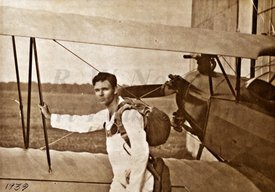
|

|
|
|
|
Minor was born in Texarkana, Texas as one of three children to Justielien Vinck, Jr., a glasscutter from a family of glass workers, and Lillie Cornelia Post. When he was six, his father was killed in a work-related accident. To raise her family, his mother worked for a clothing store, clerked for the Holman Hotel, and served as night clerk for the Yellow Cab Company. As a child, Minor quickly showed a propensity for art. "I used to like to draw and when we were little kids we'd play in the sand and make different designs and things in mud," he recalls. He enjoyed movies, and remembers seeing the first film with sound shown in Texarkana. In other leisure times he went hunting and fishing. Minor quit school while he was in the eighth grade. In 1932, at age 16, he began working at Texarkana Glass and Mirror Works, his father's former employer. There, his father's best friend had promised to hire Minor and his brother when each turned 16. "And that's when I started," he remarks of his career in glass. He learned beveling, cutting and installing automobile and window glass. Duties ranged from "sweeping the floor to delivering merchandise to cutting glass and even picture framing," he recalls. "When there was nothing to do I would pick up some pieces of glass out of the scrap box and I would do little art pieces, little birds and flowers and things." Minor also worked for a grocery-drug store, and helped out on his grandparents' farm. He helped Henry Ray restore an airplane and began barnstorming, or performing in air shows at local airfields. At age 16, with another barnstormer, Harold Bell, he made his first parachute jump. Minor obtained his parachute rigger license and packed parachutes at flight schools in Texas, Oklahoma, Mississippi and Louisiana. He also took pilot training. Minor, who earned the nickname "Mile High Vinck", estimates that he made more than 100 jumps. He was also a wing walker. On July 3, 1937 he married Ruth Webb. (They would have two children, three grandchildren and five great-grandchildren.) The couple moved to Shreveport where Minor went to work for Pittsburgh Plate Glass Company. About 1940 he went to work as an apprentice glasscutter to his uncle at Libbey-Owens-Ford Glass Company. On the side, he inspected parachutes and continued barnstorming. He also devoted free hours to his studio at home, where he took in commissions in engraving, stained glass and beveling. "I'm self-taught," he says of his talents. Minor entered the U.S. Army Air Forces in December of 1943, and took basic training at Camp Wolters in Mineral Wells, Texas. He was then transferred to Air Transport Command at Sheppard Field in Wichita Falls, Texas. At Kingman, Arizona, he helped strip old combat airplanes for their parts. At Westover, Massachusetts he received a military occupational specialty (MOS) as a cook. Sent to Bluie West One, an air base in Greenland, Minor was assigned to the parachute shop where he packed drop chutes. In summer of 1945, he flew home on a B-17 and was discharged at Fort Bragg in North Carolina. Back in Shreveport he returned to his job at Libbey, where he worked until the plant closed in 1971. He then opened Vinck Studios, where he created many kinds of glass works, and was much in demand for his leaded beveled glass doors and windows. He also created stained glass windows for many local churches, as well as glass murals for the Petroleum Club overlooking Cross Lake. He also created small works, such as wine glasses, and took on restoration work, once repairing antique perfume bottles. For one commission he created a "seven- or eight-pound" crystal bearing the coat of arms of the family of Pope Benedict XVI. Minor closed Vinck Studios in 2007, in all spending 75 years in glass. In recent years Minor has launched his talents into gun engraving, working mainly with metal marking pen, stylus, and small hammer and chisel. |


